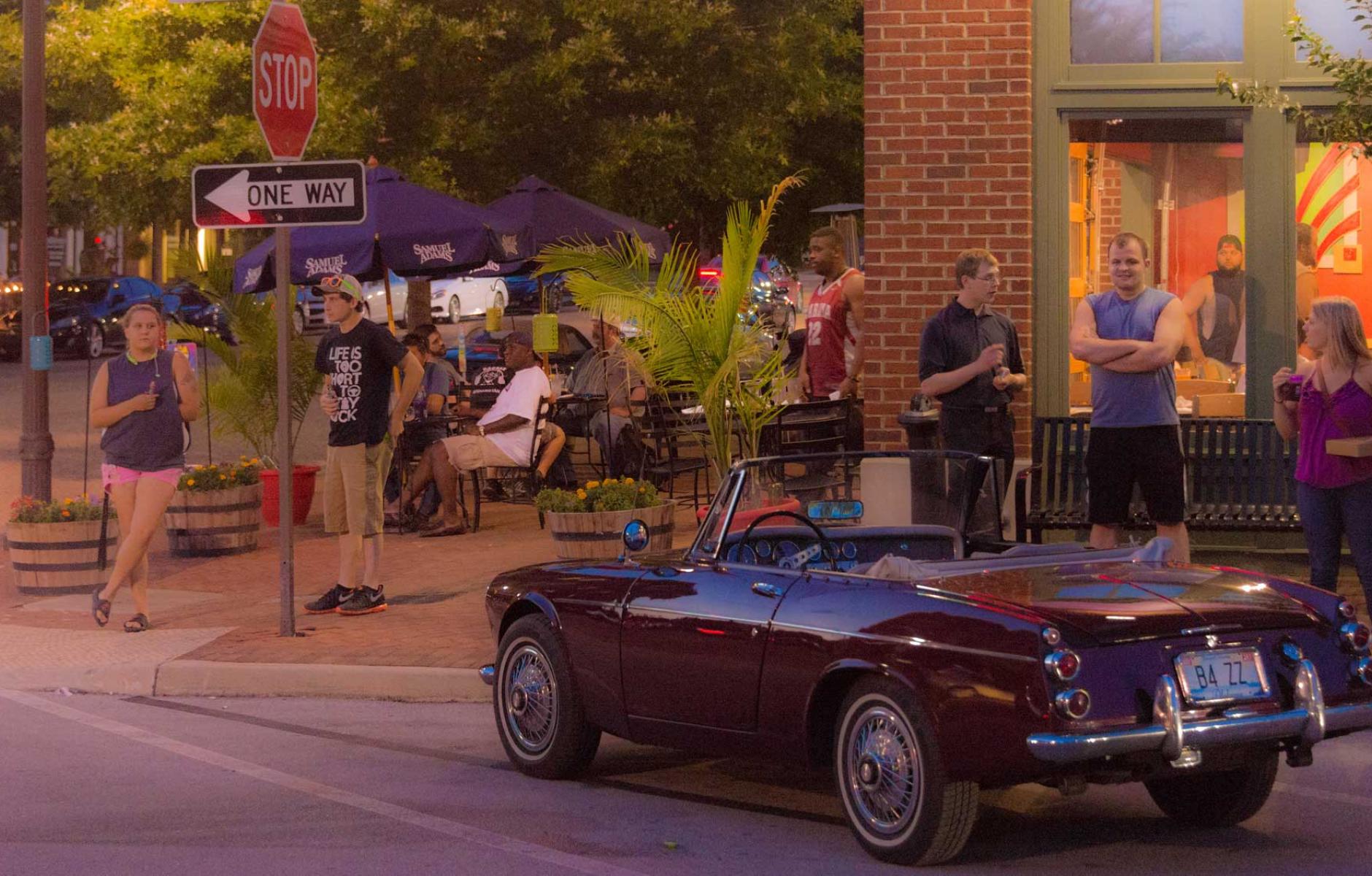
Twelve steps of sprawl recovery
The storm clouds of sprawl addiction had been gathering for years, but it took the Meltdown and the ensuing Great Recession to make it clear just how damaging that addiction had been to the health of cities across the US and abroad. Sprawl has two really big things going for it, but three even bigger things now going against it which are poised to turn the tide against the pattern of sprawl.
Sprawl's two enablers
Sprawl development is, at its foundation, an industrial system, developed in the 1940s on the shiny and new mentality of the assembly line. The first enablers of sprawl are the core manufacturing systems that produces the subdivisions, strip malls, office parks, mega-stores, mega-churches, and mega-schools, and the mega-highways necessary to serve them all. The second enabler is the collection of support industries built around the core of sprawl: market surveys, zoning, infrastructure engineering, design, and their sprawl based standards, codes, and regulations, development lending and sprawl-based development practices, appraisals and home mortgages and mortgage bundling, “site-adapt” cookie-cutter building design, square-feet-bells-and-whistles real estate sales, plus all of the financial, design, development, and sales industry organizations, and the shelter publications and shows to support this behemoth. Because the parts were industrially designed to interact seamlessly with each other, and preclude any other way of building, it looked like an immovable rock for decades. Until the cracks in the infrastructure began to show.
The three interventions
Three immense waves are now crashing against the monolith of sprawl, and promise to intervene in our current path to national, state, and local bankruptcy. The first is the relations between workplace and workers. The generation of workers who would follow a job across the country or even abroad is now retiring. Millennials turn the job hunt on its head, seeking first a cool city or town, then the coolest neighborhood in that town, then a job they like in that neighborhood. Cool Factor, on display in this image, is now what drives employment. And there is no place in America more devoid of Cool Factor than an office park, and a subdivision is close behind. Today’s slide is just the beginning of a precipitous drop in demand for boring places to work and live.
The second great wave is also generationally-based, but more mathematical than the preferences for places with Cool Factor. For all of our lifetimes until just a few years ago, there have been net purchasers in the US housing market. Now, for the rest of most of our lives, there will be more sellers than purchasers. For a half-century, we’ve been assured that home prices will rise. Now, for houses located in ordinary subdivisions, the prognosis is very poor: falling real estate values as far as the eye can see. There is a solution: sprawling places that elect for an extreme makeover into vibrant and sustainable places can actually run against the tide and increase their values. But those which stay the current course cannot resist the value decline with any amount of wishful or “magical" thinking.

The third wave is eqally inexorable: the failure of sprawl infrastructure. But this one is pure math and has nothing to do with Boomers, Millennials, or any other generation. Get to know two names really well: Joe Minicozzi and Chuck Marohn. They’re very different in so many ways: from different parts of the country, from different sides of the political spectrum, one a lone wolf and the other the founder of a movement with a small army and annual gatherings, but they are highly aligned as the two prophets of the end of sprawl. They show (in two very different ways, as you may have guessed by now) how that sprawl is a huge Ponzi scheme, and how it will collapse on the weight of its own infrastructure maintenance. “Do the math,” as Joe says… it shows a terrifying calculation no city wants to see: there is a date at which every city in the US with a lot of sprawl will go bankrupt because of the cost of maintaining the infrastructure. It’s not a question of if, but of when. And that date can be calculated.
So make no mistake: Sprawl is an American addiction, and we must break it or it will break us. Cities cannot afford to maintain the sprawl developers have built, and the infrastructure bills are beginning to come due in greater quantities than ever. For sprawl, it's recover or die. Do the math. Look it up.
The twelve steps
There is a 12-step sprawl recovery program that can transform the subdivisions, strip malls, and office parks of post-WWII sprawl into sustainable neighborhoods... IF the people living there want that extreme makeover. But they have to want it & be committed to the transformation. Without the commitment, they won’t be able to break the addiction. The 12-step sprawl recovery program can never be forced upon anyone. People have to be committed to transforming the sprawl around them into sustainable places. The benefits are many, including the fact that those places will live much longer. The alternative is bleak; there are ghost towns around the world for a reason.

Step 1: Civic space
The first step of sprawl recovery is to create at least one neighborhood civic space, which can be a plaza (for the most urban places), a square (as shown here), a green, or a park. What's important is to do it at the beginning. If you wait, it'll be too expensive later on because property values will likely rise as the neighborhood recovers. A centrally located vacant lot can work as the neighborhood square & it adds enough value to nearby lots to pay for it. An abandoned lot works best, although one with a foreclosed building can work as well.
Squares are often the size of an entire city block, like Jackson Square in New Orleans, but a neighborhood center civic space doesn’t have to be anywhere near that large. This plaza in chicago is only 75 feet wide; I stepped it off to be sure. Incidentally, that’s about the width of some neighboring buildings, so it’s possible that this plaza was once a vacant lot before being converted into the civic space we see today.

Step 2: Thoroughfare recovery
The second step of sprawl recovery is beginning to recover the thoroughfares so that they have enough Walk Appeal that people feel just as comfortable walking and biking there as they do driving there, like they do in this picture. Part of the job involves slowing the cars down by putting the streets on a "street diet" and adding on-street parking. Another part is redesigning the sidewalks, planting beds, and street furnishing zones to entice people to come out and walk on their neighborhood streets. A third part is inserting rear lanes and service alleys to get the messy stuff off the front streets, and the means of getting property owners to give up the back 10’ to 15’ of their lots and be happy about it will be the subject of an entire future blog post.
Multi-modal transport is very important at this step, especially the self-propelled modes of walking and biking. Get these right and Walk Appeal flourishes and many good things happen. Get them wrong, and you're stuck with the auto-dominated place you have now, where people spend more quality time with their steering wheels than with their families. There's an added benefit to the self-propelled means of getting around: neighbors will get more exercise, stay healthier, and actually be happier, which is a proven benefit of getting out and getting around on your own power.

Step 3: Accessory dwelling units
This step adds accessory dwelling units like the apartment over this garage in order to add neighbors to the neighborhood because subdivisions in sprawl rarely have anywhere near enough neighbors to support neighborhood businesses. Some people worry that "those people won't be just like us," but a variety of people make a place more interesting, and you have control over who you rent your accessory unit to; it's not like anyone is putting up high-rise apartment blocks next door. And your tenant might even be your own kid, who has just graduated from college. Also, some cities and states are now passing laws legalizing accessory dwelling units (also called ADUs or “granny flats”) because while they’ve been used all over American and around the world for all of human history until recently, they’ve been illegal in the US since roughly the end of World War II. So if you’re living in a place that is now making them legal again, you’re one step ahead.

Step 4: Gifts to the street
Encouraging neighbors to give "gifts to the street" is the next step. Gifts can delight people (like a beautiful frontage garden), entertain them (like a great storefront), refresh them (like a street fountain or even a sidewalk café), shelter them (like an awning or gallery), direct them (like a goal in the middle distance), inform them (like a clock or sundial), help them remember (like a memorial), or simply give them a place to rest. Whatever each gift may give to the street, there's no doubt that the collection of gifts will make the street a much more interesting place to walk.

Step 5: Lovable edible gardens
The next step of sprawl recovery is encouraging lovable edible gardens throughout the neighborhood, and also establishing a farmers market for those who don't want to raise a garden themselves. Fresh local food does much good for a neighborhood… so much so that these benefits will occupy an entire future post. It’s also really important that the edible gardens be treated with every bit as much care as ornamental gardens. Today, most vegetable gardens are treated with similar aesthetic respect to a utility room. For most people, that means “not much." As a result, many cities ban vegetable gardens in front yards because they can be eyesores. Recovering neighborhoods need to learn how to do edible gardens beautifully again, as our ancestors once did.

Step 6: Places to eat
Restaurants tend to be risk-oblivious, so they should be the first business type introduced to your recovering neighborhood (probably around the neighborhood square) as Step 6 of sprawl recovery. Small restaurants fit well in existing houses like the one shown here. But be careful where you put them, especially at the beginning. Quiet restaurants can fit well on most street corners because they close earlier and don't disturb the neighbors, but those with a younger clientele or that serve alcohol should be limited to around the neighborhood square, and should only be added later, once the neighborhood has a strong track record of beloved establishments.

Step 7: Bed and breakfast
Add a bed and breakfast at Step 7 so subsequent houses aren't burdened with needing a guest suite and can therefore be smaller if desired. Before the Meltdown in 2008, a guest suite in many suburban houses included a bath and often even a walk-in closet, frequently tipping the scales at 250 square feet or more. At $200 per square foot, the necessity of having a guest bedroom inflated the mortgage by $50,000 or more. The mortgage savings can more than pay for putting your guests up at the B&B.

Step 8: Cottages
By this time, your recovering neighborhood is ready for Step 8 of sprawl recovery, which is the construction of small cottages throughout the neighborhood so you can invite more neighbors to live there and help support the growing collection of neighborhood businesses. Because they're small, cottages can slip into many underused parts of a neighborhood, including along rear lanes or in cottage courts carved into the middle of a block. Having smaller homes in the neighborhood expands the affordability range, allowing young adults to live just down the street from their parents for the first time in nearly a century.

Step 9: Live/work units
Step 9 is construction of live/work units so you can open a small business and live above the shop. America was built by people living over the shop; live/work units were only banned after World War II, when planners decided to segregate homes not only from factories, but from everything else as well. Recent decades have seen countless corporate job losses, and many of those people have gone in business for themselves. Now, just as it was when the US was founded, there is no better place to cultivate your own business than in a live/work unit.

Step 10: Neighborhood market
Your neighborhood should be mature enough in its recovery by this point that you're ready for Step 10, which is a dedicated neighborhood market. This one has apartments above, but the owner may live elsewhere in the neighborhood. One really important note about neighborhood markets: retail experts may tell you that they need to be at least 40,000 square feet to be successful, and this is true in sprawl, where they're often much larger. But in a walkable neighborhood, they can be much smaller. There are even single-crew groceries of less than 1,000 square feet, and a grocery of 5,000 square feet can stock everything in a convenience store, plus healthy food as well.

Step 11: Dedicated office & retail
This step of sprawl recovery is the construction of dedicated office and retail space. On quiet streets, it might be just a small home office for one person built tight up to the sidewalk; larger establishments fit better around the neighborhood square. Look at old town centers, and you'll see that some of these shops and offices are quite small, and are built in the front yards of homes near the town center. In other cases, homeowners eventually redeveloped their homes as dedicated office and retail, like the shops shown here.

Step 12: Civic buildings
The final step is the addition of civic buildings, if you haven't added them already. A meeting hall, wedding chapel, or place of worship are all candidate civic building types; your neighborhood's needs may be different, so build the ones you need. Civic buildings in the US often sit on a square or plaza, but while that's nice, it's not necessary. Most of them do need space for a crowd to spill out in front, so setting them back from the street is one way to do this. Another is to place them in a location where the streets swells out, creating a small civic space that might be as simple as an extra-wide sidewalk.
We realize that an extreme makeover of your neighborhood sounds like a scary thing. It is because it's a big change. But it's the kind of change that can transforms ordinary subdivisions and strip centers into a vibrant and sustainable neighborhoods that can join the ranks of the Most-Loved Places someday. Good luck, and let’s talk about the challenges and techniques of making this happen!
This article was published on the Original Green blog.




